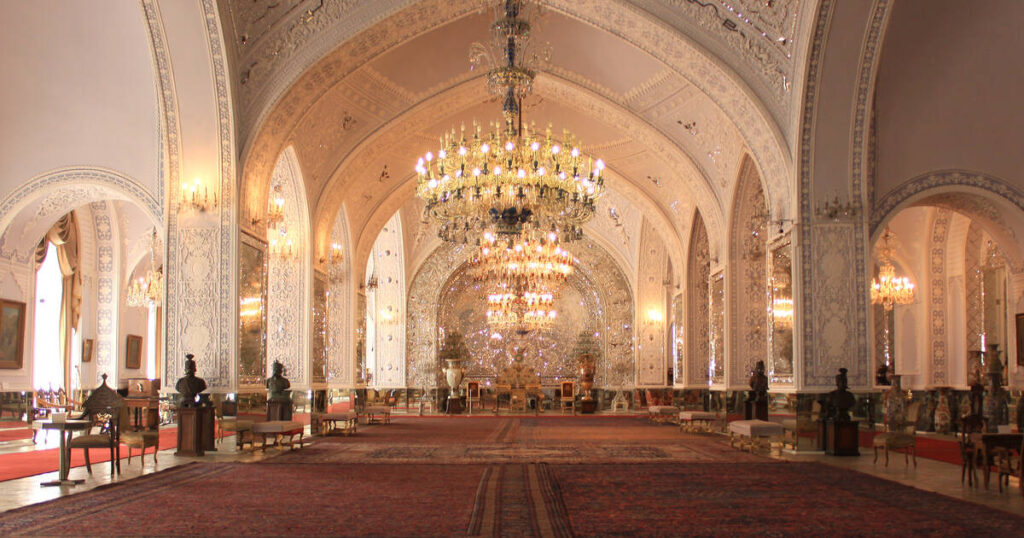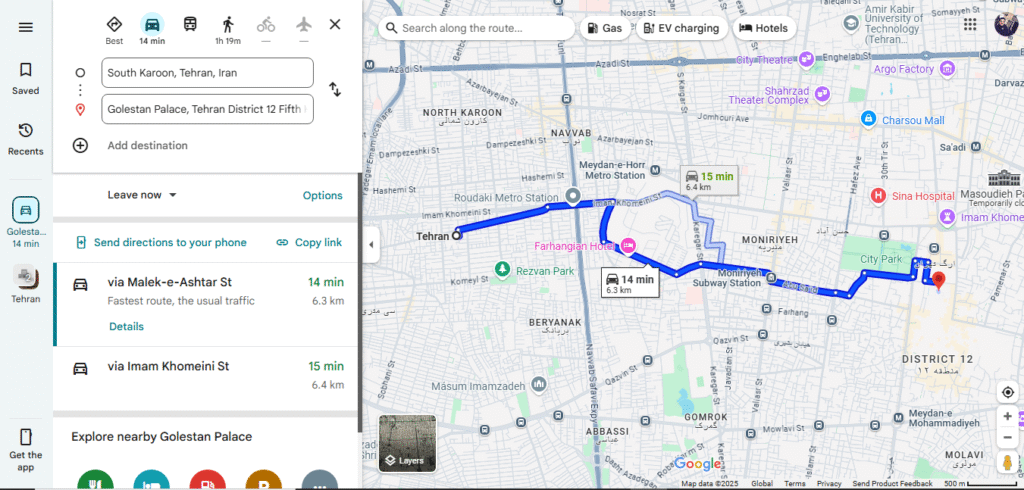
To begin with, Golestan Palace, nestled in the bustling heart of Tehran, is more than just a historical site—it’s a symbol of elegance, artistry, and the Persian spirit. In addition A UNESCO World Heritage Site, Golestan Palace in Tehran is a stunning reminder of the Qajar dynasty’s glory and a must-see destination for travelers seeking authentic Persian heritage.
Whether you’re a history buff, an architecture lover, or a cultural explorer, this majestic complex deserves a spot on your list of things to do in Tehran. Thus at Azadi Hospitality, we’re dedicated to helping guests uncover Iran’s most captivating destinations. In this article, we’ll take you through everything you need to know about Golestan Palace, from its rich history to travel tips, nearby attractions, and more.
A Brief History of Golestan Palace
Golestan Palace (Kakh-e Golestan), meaning the “Palace of Flowers,” was originally built during the Safavid dynasty in the 16th century but reached its peak during the Qajar era (late 18th to early 20th centuries). The Qajar kings used it as their residence and ceremonial palace, which explains its blend of traditional Persian architecture with European influences.
In the 19th century, Naser al-Din Shah Qajar, inspired by his travels to Europe, initiated renovations that brought Neoclassical elements, mirror halls, and grand courtyards into the palace complex. Today, Golestan Palace remains a remarkable example of the fusion between Persian tradition and Western modernity.
In 2013, UNESCO recognized the palace as a World Heritage Site, noting its influence on Iranian art and architecture and its reflection of the modernization era in Iran.
What to See Inside Golestan Palace
Golestan Palace is a complex of royal buildings, museums, and gardens. Each section has its own story, filled with art, politics, and grandeur. Here are the highlights:
1. Shams-ol-Emareh (Edifice of the Sun)
This five-story tower, built in 1867, was one of the tallest buildings in Tehran at the time. With its elegant tilework and panoramic view of the old city, it was designed to rival European clock towers. Today, it’s a symbol of Tehran’s transition into modernity.
2. Marble Throne (Takht-e Marmar)
Housed in an open-air pavilion, this stunning throne is made from yellow marble and sits under an ornate roof supported by delicate columns. It was used for royal receptions and coronations, including the crowning of Reza Shah Pahlavi.
3. Hall of Mirrors (Talar-e Ayeneh)
Possibly the most famous room in the palace, the Hall of Mirrors features dazzling mirror mosaics, crystal chandeliers, and exquisite plasterwork. And it became iconic thanks to the painting of Naser al-Din Shah sitting in this very room.
4. Ivory Hall and Brilliant Hall
In particular, both these spaces are richly decorated with mirrored ceilings, stucco carvings, and luxurious furnishings. And they were used for royal banquets and state ceremonies.
5. Negar Khaneh (Gallery of Paintings)
This gallery features stunning Qajar-era paintings, European-style portraits, and gifts received by the kings. It offers a glimpse into how Persian royalty interacted with global powers.
6. Abyaz Palace (White Palace)
Built to house diplomatic gifts from the Ottoman Empire and Europe, the Abyaz Palace has now become the Ethnological Museum, showcasing regional Iranian attire and cultural items.
Why Visit Golestan Palace?
If you’re wondering why Golestan Palace should top your Tehran travel itinerary, here’s why:
- It’s one of the oldest historic monuments in Tehran.
- It offers a visual journey through Persian royal life, art, and architecture.
- Its European-Persian hybrid design is unlike any other royal complex in Iran.
- It’s surrounded by bazaars, mosques, and local cafés, offering a full-day cultural experience.
- It’s easy to access via Tehran’s metro and close to Azadi Hospitality’s partnered accommodations.
Best Time to Visit Golestan Palace
The best times to visit Tehran and enjoy Golestan Palace are during the spring (April–June) and autumn (September–November), when the weather is mild and pleasant. Moreover the gardens bloom in spring, making the palace even more photogenic.
Visiting early in the morning helps you beat the crowds, especially during Iranian holidays or weekends (Thursday and Friday). The palace is typically open daily, except for national holidays, from 9 AM to 5 PM.
How to Get There
Golestan Palace is located in District 12, Tehran’s historical core. The easiest way to reach it is via the Panzdah-e Khordad Metro Station on Line 1 (Red Line). From there, it’s a short walk through the Grand Bazaar area.
Address: Panzdah-e Khordad Street, Tehran, Iran
Entrance fee: Fees vary for each section, but expect to pay a base fee and additional tickets for galleries.
Travel Tips from Azadi Hospitality
At Azadi Hospitality, we go beyond just booking your stay—we help you create lasting memories. Here are a few tips to help you get the most from your Golestan Palace experience:
- Buy a combined ticket to save money and see all the palace’s sections.
- Hire a local guide or download an audio guide to understand the deep historical context.
- Dress modestly, as required in public Iranian spaces.
- Bring cash (Iranian rial), as international cards are not accepted.
- Don’t miss the photography museum, located in one of the side buildings.
Nearby Attractions
Extend your journey into Tehran’s rich history by visiting these nearby sites:
1. Grand Bazaar
Just a short walk from Golestan Palace, the Tehran Grand Bazaar is a maze of commerce and culture. It’s a great spot to buy Persian carpets, handicrafts, or just observe local life.
2. National Museum of Iran
Located about 15 minutes away by car, this museum features relics from ancient Persia, including Achaemenid, Parthian, and Sassanid artifacts.
3. Imam Mosque (Shah Mosque)
This Qajar-era mosque, not to be confused with the one in Isfahan, stands near the Grand Bazaar. Its dome and minarets reflect classic Persian-Islamic architecture.
Where to Stay: Azadi Hospitality’s Recommendations
Looking for a comfortable, elegant place to stay near Golestan Palace?
At Azadi Hospitality, we recommend curated stays in central Tehran, where history meets luxury. Our network of boutique hotels and guesthouses ensures:
- Quick access to historical sites like Golestan Palace
- Modern comfort paired with traditional Iranian charm
- Personalized concierge service to plan tours, transport, and dining
Ask our travel concierge about custom Golestan Palace tours, or bundle your trip with culinary experiences and guided bazaar visits.
Final Thoughts
Golestan Palace is not just a historic building—it’s a living museum of Iran’s royal past. From its glittering halls and European mirrors to Persian tilework and tranquil gardens, it’s a place where every corner tells a story.
In conclusion, whether you’re traveling solo, with family, or on a cultural tour, visiting Golestan Palace is one of the top things to do in Tehran. Let Azadi Hospitality help you make the most of your journey with tailored experiences and exceptional stays.
Ready to explore Iran’s royal legacy?
Plan your visit to Golestan Palace Tehran with Azadi Hospitality today.
